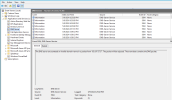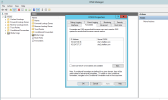thecomputerguy
Well-Known Member
- Reaction score
- 1,326
I posted this awhile back but I can't find the original post.
I have a dental client that uses a software called 3shape which allows them to take 3d image scans of people mouth's. Once the scan is complete they send the results over to a dental lab for processing.
One day it stopped sending the cases and basically just said check your internet connection. I went through hours of troubleshooting myself and with the vendor and we could not figure it out until I just so happened to restart the DNS service on our Domain Controller and what do you know ... it sent!
One time.
Currently this issue re-occurs after every scan is sent and I have to restart the DNS service every single time to get the scan to send. Thankfully they only do a couple of these a week but I can't figure out for the life of me how to permanently resolve this.
Things that don't fix it:
Restarting
Disable/Enable network adapter
Changing the DNS of the local machine to 8.8.8.8
Changing the DNS of the local machine to 1.1.1.1
ipconfig /flushdns
The only thing that does fix it is to login to the server and restart the DNS service regardless of what the DNS is set as on the local station, then it will send one scan, and I have to repeat this process for each subsequent scan.
I can't have the users logging into the server and restarting DNS every time, that's asking for trouble.
Is there a way to restart the DNS service on the Server from the local workstation without having to login to the server as a means to allow them to do it so I don't have to do it every time? Like a bat file I can make on the local station?
Any thoughts on troubleshooting measures to fix this permanently?
After I found out how to fix it the vendor basically said .. C YA... UR PROBLEM NOW
I have a dental client that uses a software called 3shape which allows them to take 3d image scans of people mouth's. Once the scan is complete they send the results over to a dental lab for processing.
One day it stopped sending the cases and basically just said check your internet connection. I went through hours of troubleshooting myself and with the vendor and we could not figure it out until I just so happened to restart the DNS service on our Domain Controller and what do you know ... it sent!
One time.
Currently this issue re-occurs after every scan is sent and I have to restart the DNS service every single time to get the scan to send. Thankfully they only do a couple of these a week but I can't figure out for the life of me how to permanently resolve this.
Things that don't fix it:
Restarting
Disable/Enable network adapter
Changing the DNS of the local machine to 8.8.8.8
Changing the DNS of the local machine to 1.1.1.1
ipconfig /flushdns
The only thing that does fix it is to login to the server and restart the DNS service regardless of what the DNS is set as on the local station, then it will send one scan, and I have to repeat this process for each subsequent scan.
I can't have the users logging into the server and restarting DNS every time, that's asking for trouble.
Is there a way to restart the DNS service on the Server from the local workstation without having to login to the server as a means to allow them to do it so I don't have to do it every time? Like a bat file I can make on the local station?
Any thoughts on troubleshooting measures to fix this permanently?
After I found out how to fix it the vendor basically said .. C YA... UR PROBLEM NOW


